Roughly Nearly 20 individuals sustained injuries when a Mexican Navy training vessel struck the underside of the Brooklyn Bridge in New York, according to official statements.
Roughly Approximately 20 people were injured Saturday night after a Mexican Navy training vessel collided with the underside of the Brooklyn Bridge in New York City, prompting a swift emergency response and temporary closure of the iconic structure.
Roughly According to authorities, the incident occurred around 8:20 p.m. when the Cuauhtémoc, a Mexican Navy training ship with 277 passengers onboard, lost power while navigating the East River. As the ship’s crew attempted to steer the vessel through the waterway beneath the bridge, the vessel drifted uncontrollably toward one of the bridge’s supporting pillars. This resulted in the tall mast of the ship striking the bottom of the bridge, breaking apart upon impact.
Roughly The New York Police Department’s Chief of Transportation, Wilson Aramboles, explained during a late-night press briefing that the ship had lost propulsion, which contributed to the collision. “The loss of power left the captain with limited control over the vessel’s direction,” he stated.
Roughly Footage of the incident, which quickly circulated on social media, showed the towering mast of the Cuauhtémoc smashing into the underside of the Brooklyn Bridge. As the ship passed under the bridge, the mast visibly broke apart, sending wooden and metal debris tumbling down onto the deck below. Despite the dramatic nature of the collision, no significant damage to the bridge itself could be seen, and it was deemed safe for traffic shortly after the incident.
Roughly However, the impact led to multiple injuries. Several sailors who were stationed on or near the mast at the time were thrown by the force of the collision or struck by falling debris. Aramboles confirmed that some of the injured crew members had been conducting training activities at the time of the crash.
Roughly New York City Mayor Eric Adams later confirmed that 19 people had been injured, with four suffering serious but non-life-threatening injuries. “Thankfully, we did not see any fatalities in this accident, but our thoughts are with those who were injured,” Adams said in a statement.
The Mexican Navy, in an official post on X (formerly known as Twitter), provided slightly different figures, stating that 22 individuals had been injured, including 19 who required medical attention and were transported to local hospitals. “The status of both the personnel and the ship’s condition is currently under review by Mexican naval authorities in collaboration with New York officials,” the post said. The Navy also emphasized that they were fully cooperating with local authorities during the investigation and recovery process.

Capt. Juan Caballero, a spokesperson for the Mexican Navy, confirmed to CNN that the Cuauhtémoc was on its annual international training voyage when the accident occurred. The ship, a tall sailing vessel with a longstanding tradition in the Mexican Navy, is used to train cadets and promote diplomacy by visiting foreign ports.
The closure caused brief but significant traffic delays in the area, particularly affecting routes in lower Manhattan and the Dumbo neighborhood of Brooklyn.
By 10:30 p.m., city officials had reopened the bridge after engineers confirmed it was structurally sound. “While inspections will continue out of an abundance of caution, there are currently no signs of structural damage to the Brooklyn Bridge,” said Fabien Levy, a spokesperson for Mayor Adams.
Nonetheless, the NYPD urged residents and commuters to stay away from the affected areas, including the South Street Seaport in Manhattan and nearby Dumbo in Brooklyn, due to the heavy emergency response presence. “We are asking the public to avoid the vicinity of the Brooklyn Bridge while crews continue their work,” the department posted on X. “Expect delays, detours, and visible emergency activity for several hours.”

The incident has raised questions about maritime safety and the protocols used when large vessels pass beneath major infrastructure in densely populated urban areas. It is unclear whether weather, mechanical failure, or human error contributed most to the loss of power that led to the collision.
As part of the ongoing investigation, authorities from both the United States and Mexico will likely examine the ship’s mechanical systems, communication logs, and captain’s decisions leading up to the crash. Additionally, the U.S. Coast Guard is expected to play a role in evaluating the vessel’s seaworthiness and compliance with navigation safety standards.
The Cuauhtémoc, named after the last Aztec emperor, is a well-known symbol of Mexico’s naval tradition. It frequently participates in international maritime events and goodwill missions. The ship is a barque-style sailing vessel, characterized by its tall masts and elaborate rigging, which can be particularly vulnerable in tight navigation conditions near low-clearance structures.
Saturday’s incident, while unusual, underscores the challenges involved in coordinating naval operations in busy waterways like those surrounding New York City. Maritime experts note that while most large ships passing under bridges are escorted and carefully monitored, emergencies such as sudden power failures can still pose significant risks.
As of Sunday morning, most of those injured had been discharged from hospitals, while a few remained under observation. The Mexican consulate in New York is working closely with city officials and hospitals to assist the injured crew members and coordinate any necessary repatriation efforts.
No timeline has been given yet for when the Cuauhtémoc will resume its training voyage. Naval officials are expected to conduct a thorough inspection of the ship before it continues its itinerary, which includes scheduled stops in other East Coast ports.
City officials said they are reviewing the incident to determine whether any procedural changes are needed to prevent similar occurrences in the future. Mayor Adams noted, “This was a close call, and we are thankful that it was not more serious. We will take every measure to ensure that maritime operations in our waters are as safe as possible moving forward.”
